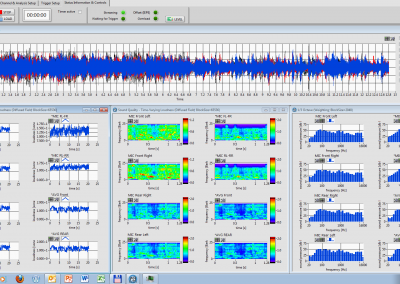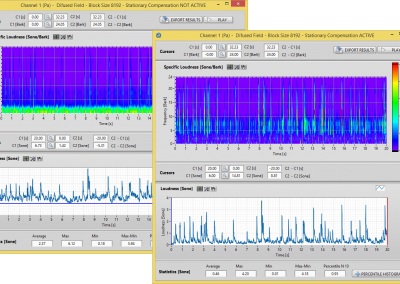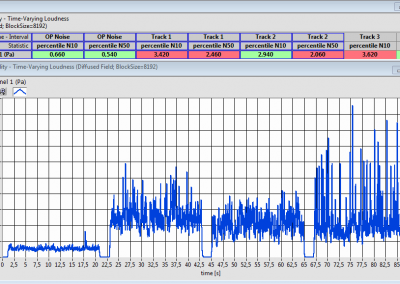Objective metrological evaluation of Buzzes, Squeaks & Rattles
A sufficiently quiet test environment and the use of quiet shakers is a basic requirement for meaningful Squeak & Rattle analyses. Noise must not be masked by the operating noise of the shaker system and other background noises. However, the resulting background noise is influenced by the setup of the shaker, the floor properties and room acoustics of the test room and the sound radiation characteristics of the test specimen as well as the fixing elements used. The measurement results can therefore fluctuate significantly depending on the setup and test environment.
The new developed algorithm is based on the calculation of the loudness of time-varying noises according to DIN 45631/A1 and enables the compensation of the quasi-stationary background noise. The influence of background noise is minimized, while instationary or impulsive noises are detected more clearly. Tests with different excitation profiles and components can be performed without adapting the analysis. Objective Squeak & Rattle tests are comparable and can be performed quickly and easily.
- 4-16 measuring channels (scalable) incl. switchable IEPE power supply
- 24bit A/D converter with sampling rates up to 105.4kHz
- High real-time bandwidths by supporting multi-core technology
- Time data recording parallel to real-time analysis
- Recording, analysis & testing against definable thresholds in real-time Freely definable high-pass, low-pass and bandpass filters
- Loudness of time-variant noises according to DIN45631/A1
- Level statistics: Nx Percentile level, Max, Min, Max-Min and mean value
- Specific loudness spectra over time (sonogram)
- Switchable background noise compensation improves reproducibility and comparability of Squeak & Rattle tests in different test environments
- Reduces the influence of room acoustics on the objective test result
- Improves the differentiation between good and bad specimens
- Automatically adapts to different excitation signals
- Simple & safe: Works with different road profiles and test specimens without adjustments to the resulting background noise
- Suitable for SINE, RANDOM & TIME HISTORY vibration tests
- Calculation of Nx percentile levels over up to 4 user definable time intervals in real- time – no further offline analysis required!
- Real-time testing enables sample testing during production and line-integrated testing
- Objective Squeak & Rattle tests with multiple road profiles in a single run
- Optional test sequencer enables fully automated test sequences including vibration control and climatic chamber control
- Use of additional standard analyses such as Lp and 1/n octave spectra
- Testing of analysis results against definable threshold values, threshold value curves or reference spectra
- Time-synchronous playback & analysis of recorded audio data
- Cutting and filtering of recorded noise
- Playback of freely selectable signal sections
- Export to WAVE audio file format
- Import of externally recorded measurement data (TXT, CSV, WAV, RPC III, HDF)
- Conversion of recorded measurement data and measurement results into common standard formats (TXT, CSV, WAV, RPC III…)
- Direct transfer (copy & paste) of measurement data and graphs to Office programs for further processing and documentation
- Recommended operating system: Windows 10
- Objective Squeak & Rattle tests according to various test specifications such as GMW14011, FORD CETP-L413, PSA with switchable adaptive background noise compensation (Adaptive Background Noise Compensation)
- Analysis, documentation and evaluation of Squeak & Rattle, functional and operating noises
Systems with 4 to 16 input channels – USB powered
| 4-16 input channels, USB powered: MB 452-I 4-channel USB frontend | ||
| Analog inputs: | 4, simultaneous sampling, 24-bit A/D converter | |
| Max. sampling rate: | 52.7kHz per channel | |
| IEPE-power supply: | 4mA, software switchable for each channel | |
| Input Voltage Ranges: | ±10V, ±1V | |
| Coupling: | AC/DC, AC cut-off frequency @ 0.1Hz | |
| Analog outputs: | 1, 24-bit D/A, ±10V output voltage | |
| Trigger: | External (digital) od Threshold (analog) | |
| RPM-Input: | 1, input voltage range ±30V | |
| Cascadable: | Yes, synchronization of up to 4 modules resulting in max. 16 input channels |
|
| Power supply: | USB powered, no external power supply | |
Systems with 16 input channels
| 16 input channels: DT9857 16-channel frontend | ||
| Analog inputs: | 16, simultaneous sampling, 24-bit A/D converter | |
| Max. sampling rate: | 105.4 kHz per channel | |
| IEPE-power supply: | 4mA, software switchable for each channel | |
| Input Voltage Ranges: | ±10V, ±1V | |
| Coupling: | AC/DC, AC cut-off frequency @ 0.1Hz | |
| Analog outputs: | 2, 32-bit D/A, ±10V output voltage range | |
| Trigger: | External (digital) or Threshold (analog) | |
| RPM-Input: | 1, input voltage range ±30V | |
| Digital I/O: | 16 (8 inputs, 8 outputs) | |
| Power supply: | External power supply 4,75VDC to 28VDC | |
Support of Sound Cards (internal & external)
If no other hardware is available BSR SUITE enables the use of internal or external sound cards for 2 channel data acquisition and analysis during training sessions or demonstration. However the use of standard sound cards for NVH and BSR testing is not recommended! MB Dynamics cannot test and guarantee the correct function of different soundcards, hardware drivers and the resulting accuracy of measurement data. In addition sound cards can also be used for online monitoring of selectable input channels and playback of recorded time signals.
- 4-16 measuring channels (scalable) incl. switchable IEPE power supply
- 24bit A/D converter with sampling rates up to 105.4kHz
- High real-time bandwidths by supporting multi-core technology
- Time data recording parallel to real-time analysis
- Recording, analysis & testing against definable thresholds in real-time Freely definable high-pass, low-pass and bandpass filters
- Loudness of time-variant noises according to DIN45631/A1
- Level statistics: Nx Percentile level, Max, Min, Max-Min and mean value
- Specific loudness spectra over time (sonogram)
- Switchable background noise compensation improves reproducibility and comparability of Squeak & Rattle tests in different test environments
- Reduces the influence of room acoustics on the objective test result
- Improves the differentiation between good and bad specimens
- Automatically adapts to different excitation signals
- Simple & safe: Works with different road profiles and test specimens without adjustments to the resulting background noise
- Suitable for SINE, RANDOM & TIME HISTORY vibration tests
- Calculation of Nx percentile levels over up to 4 user definable time intervals in real- time – no further offline analysis required!
- Real-time testing enables sample testing during production and line-integrated testing
- Objective Squeak & Rattle tests with multiple road profiles in a single run
- Optional test sequencer enables fully automated test sequences including vibration control and climatic chamber control
- Use of additional standard analyses such as Lp and 1/n octave spectra
- Testing of analysis results against definable threshold values, threshold value curves or reference spectra
- Time-synchronous playback & analysis of recorded audio data
- Cutting and filtering of recorded noise
- Playback of freely selectable signal sections
- Export to WAVE audio file format
- Import of externally recorded measurement data (TXT, CSV, WAV, RPC III, HDF)
- Conversion of recorded measurement data and measurement results into common standard formats (TXT, CSV, WAV, RPC III…)
- Direct transfer (copy & paste) of measurement data and graphs to Office programs for further processing and documentation
- Recommended operating system: Windows 10
- Objective Squeak & Rattle tests according to various test specifications such as GMW14011, FORD CETP-L413, PSA with switchable adaptive background noise compensation (Adaptive Background Noise Compensation)
- Analysis, documentation and evaluation of Squeak & Rattle, functional and operating noises




